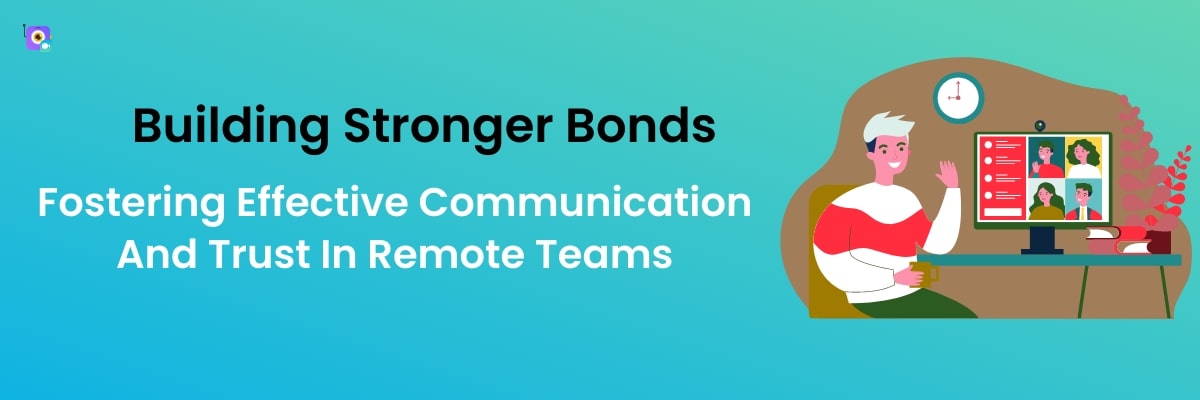Contents
Understanding the Dynamics of Remote Teams
Communication Strategies for Remote Teams: Video Communication
Interactive Workshops: Fostering Engagement and Collaboration
The Role of Leadership in Fostering Communication and Trust
Evaluating and Adapting Communication and Trust Strategies
Effective Communication and Trust in Remote Teams
The prevalence of remote work is widespread, both literally and metaphorically. It is highly probable that your organization currently incorporates some form of remote work, including full-time remote employees, freelancers, consultants, or occasional work-from-home opportunities for staff.
As we embrace remote work's flexibility and opportunities, we must confront its challenges. Building effective communication and trust within remote teams is one of the most important factors to zero in on. A trained ethnographer Simon Sinek aptly expresses the essence of a cohesive team: "A team is not merely a group of people who work together, but a group of individuals who genuinely trust each other."

Let's look at how we may foster trust and productive communication in remote teams to increase their performance and output.
Understanding the Dynamics of Remote Teams
Working in a remote team may be exhilarating as well as challenging. In this section, we'll look at the definition and features of remote teams and the unique communication and trust issues they confront in virtual environments.
Definition and Characteristics of Remote Teams
Remote teams, often known as virtual teams, are groups of persons collaborating on the same purpose despite being geographically separated. They collaborate and communicate using digital tools and technology.. These teams can be totally remote, with members spread across many time zones, or they can be a mix of remote and on-site members in the company structure.
Characteristics of Remote Teams:
Challenges Faced by Remote Teams in Communication and Trust
1. Communication Barriers in Virtual Environments
Although technology has successfully addressed numerous barriers, remote teams face distinctive communication obstacles that necessitate deliberate actions. Analysis by Forbes Advisor reports that poor communication affects trust for 45% of team and leadership levels workers.
Some of these barriers include:
To address these issues, remote teams must implement effective communication tactics, practice active listening, and encourage open feedback.
2. Building Trust Without Face-to-Face Interaction
Trust forms the foundation of successful teams, but establishing it in remote settings presents a unique puzzle. Without the opportunity for casual conversations or impromptu chats, remote team members must find alternative ways to build trust:
By being intentional about communication and trust-building, remote teams can unlock their full potential and achieve remarkable results despite the geographical distance.
Communication Strategies for Remote Teams: Video Communication
Video communication has evolved as a revolutionary tool in an era where remote work has become the norm, bridging the physical difference and pouring life into virtual relationships. This section digs into video communication's enormous influence, revealing its role in humanizing remote encounters, overcoming digital fatigue, and improving overall team chemistry.
A. Rise of Video Communication Platforms in Remote Work
As the traditional conference room gave way to the virtual meeting space, a flood of cutting-edge video communication platforms emerged. Zoom, Microsoft Teams, and Google Meet quickly inherited the mantle of modern boardrooms, allowing teams to gather easily worldwide. This move has ushered in a paradigm shift, elevating video communication from a mere convenience to a critical enabler of efficient remote cooperation.
B. Using video to humanize virtual interactions
1. Dealing with Video Conferencing Fatigue
The allure of virtual meetings came with downsides. Back-to-back video conferences have given rise to a problem known as "video conferencing fatigue." Constantly gazing into screens and lacking real presence left many longing for relief. To overcome this, forward-thinking businesses have implemented "camera-off" periods and careful scheduling, ensuring that the virtual meeting setting remains energizing rather than tiring.
2. Promoting "Watercooler" Moments Through Video Chats
The virtual watercooler, a symbolic location for casual talks and spontaneous exchanges, is a critical piece in team cohesion. Video chats have reignited these serendipitous encounters, providing a virtual equivalent of random coffee breaks. These unscripted moments of interaction develop a sense of community, forging relationships beyond project meetings and KPIs.
C. Crafting Engaging Video Messages
1. Visual Storytelling in Remote Teams
When it comes to remote work, where physical cues are limited, visual storytelling takes center stage. Effective leaders use this media to tell compelling stories. Just like a captivating novel weaves a tapestry of images, persuasive video messages construct tales that motivate action and ignite shared purpose using pictures, stories, and metaphors.
2. Using Visuals and Graphics to Improve Communication
Visuals break through language barriers, making complicated topics understandable in a single glance. Infographics, charts, and diagrams serve as beacons of clarity in a sea of information. Consider a quarterly report enhanced by interactive graphs or a project roadmap brought to life by an animated timeline. By incorporating such visual aids into video communication, remote teams can access a shared visual language, reducing ambiguity and speeding up decision-making.
Interactive Workshops: Fostering Engagement and Collaboration
Fostering engagement and collaboration among remote employees has become critical in today's competitive corporate context. Virtual workshops stand out as practical tools for attaining these objectives because they cross physical borders to create a cohesive and motivated team.
Organizations that want to excel in remote team environments can use the following concepts to develop and lead effective virtual workshops.
A. Virtual Workshops as Tools for Team Building
Virtual seminars are essential for developing team cohesion and camaraderie. They cut over geographical boundaries and time zones, allowing teams to communicate, brainstorm, and invent in real-time. These workshops enable team members to exchange ideas, solve problems, and contribute to company goals by emulating the in-person experience using interactive technology.
B. Designing Engaging and Interactive Virtual Workshops
1. Gamification: Creating Collaborative Games Out of Workshops
Gamification adds excitement and competitiveness to virtual workshops, encouraging active participation and knowledge retention. Participants are encouraged to participate actively in workshop activities by introducing game-like mechanics such as points, leaderboards, and incentives.
Consider the following scenario: a sales team goes on a virtual product knowledge hunt, earning points for the correct answers and racing against the clock. This not only boosts team spirit but also provides vital product feedback in a fun way.
2. Role of Breakout Rooms in Brainstorming and Problem-Solving
Breakout rooms mimic the brainstorming meetings and water cooler chats that are essential to on-site collaboration. Dividing participants into smaller breakout groups during virtual workshops promotes focused discussions, idea production, and collective problem-solving. Consider a marketing team that has been tasked with developing a new campaign strategy.
Breakout rooms allow sub-groups to study various areas, such as target audience analysis and creative content, and then rejoin to share their findings. This strategy assures thorough coverage of the issue at hand while cultivating a sense of ownership and involvement.
The Role of Leadership in Fostering Communication and Trust
As a leader, you can set the tone and create an environment where open and transparent communication thrives, leading to stronger bonds and increased team productivity. Leadership speaker Mark Sanborn says: “People who act effectively as leaders boil down the details. They make the world easy for others to understand. Effective leaders harness the power of the sound bite in an effort to make concepts easy to understand and repeat.”
Here are some key strategies and principles that can help you foster communication and trust among your remote team members.
Leading by Example: Communication from the Top
As a leader, your actions speak louder than words. Demonstrating effective communication yourself sets the standard for your team. Be open and honest about your objectives, hurdles, and decision-making processes. Share pertinent information with your team as soon as possible, and foster an environment where everyone feels comfortable voicing their views and concerns.
Engaging in Two-Way Dialogue
Communication must be two-way. Encourage active engagement and maintain regular contact with your team members. Spend some time actively and attentively listening to what they have to say. Show real attention to their ideas and criticism, and thank them for their contributions. This creates a sense of belonging and encourages team members to share their views openly.
Empowering Team Members and Encouraging Autonomy
Trust is built on the foundation of empowerment and autonomy. Provide your team members with the necessary resources and support to accomplish their tasks. Avoid micromanaging and, instead, trust them to make informed decisions. Team members are likelier to take ownership of their job and contribute effectively to the team's success when they feel trusted and empowered.
Transparent Leadership Communication
Maintain transparency in your communication with the team. Provide timely updates on the company's direction, changes, and concerns. Outline the team's objectives and progress. This level of transparency builds trust by demonstrating your willingness to be open and honest with your team.
Recognizing and Rewarding Team Efforts
Recognizing and appreciating the efforts of your remote team members is crucial for building trust and morale. Celebrate successes and milestones, no matter how big or small. Offer positive feedback and public recognition for outstanding work. This fosters a sense of camaraderie and motivates team members to continue performing at their best. Make recognition feel real for distributed teams by pairing shout-outs with small physical badges like Custom Challenge Coins. They celebrate milestones, reinforce values, and build belonging across time zones.
Trusting Employees to Make Decisions
Remote work necessitates a level of trust in your team members' abilities. A leader can delegate tasks and responsibilities based on team members' strengths and expertise. Trust that they will approach their work with professionalism and dedication. Providing autonomy in decision-making empowers team members and promotes a culture of trust.
Practicing Empathetic Communication
Being aware of team members' unique challenges is essential in a remote setting. Practice empathetic communication, understand their circumstances, and be supportive when needed. Show empathy during difficult times, and be flexible in accommodating their needs.
Evaluating and Adapting Communication and Trust Strategies
Now that we've examined various strategies for fostering effective communication and trust in remote teams, it becomes vital to evaluate the efficacy of these approaches and be willing to adjust as necessary. Remote work environments can be dynamic, and what is effective at one time may require modifications in the future. Let's evaluate and modify our communication and trust strategies to ensure our remote team is cohesive and flourishing.
Measuring Team Communication and Trust
You need concrete metrics to gauge the effectiveness of your team's communication and trust-building efforts. Consider the following evaluation methods:
Surveys and Feedback Sessions: Conduct regular surveys and feedback sessions to collect insights from team members. Encourage honest responses about their perception of team communication, levels of trust, and any areas that need improvement.
Communication Analytics: Utilize remote collaboration tools and communication platforms to analyze message frequency, response times, and engagement data. This data can give you a quantitative overview of how well the team communicates.
Key Metrics for Assessing Team Performance
Response Times: Evaluate how quickly team members respond to messages and inquiries. Faster response times generally indicate better communication and availability.
Participation Levels: Monitor the active involvement of team members during virtual meetings, brainstorming sessions, and other collaborative activities. Higher participation signifies greater engagement and trust.
Continuous Improvement and Flexibility
Remember that communication and trust-building are ongoing processes. Embrace a growth mindset and be open to adapting your strategies as the team evolves. Here's how:
Regular Check-Ins: Schedule periodic check-ins with team members to discuss their communication preferences and any challenges they face. This ensures that you remain responsive to their needs.
Learning from Challenges and Successes: Celebrate successful communication and trust-building experiences within the team. Similarly, use challenges and setbacks as learning opportunities to fine-tune your strategies.
Final Thoughts
As remote work becomes increasingly prevalent, embracing communication and trust is essential for thriving in this new landscape. By leveraging technology, encouraging team-building activities, and continuously adapting effective strategies, we pave the way for enhanced productivity and satisfaction. Let's grasp the opportunities remote work offers, forging stronger connections and creating a dynamic and supportive environment for remote teams to flourish.



